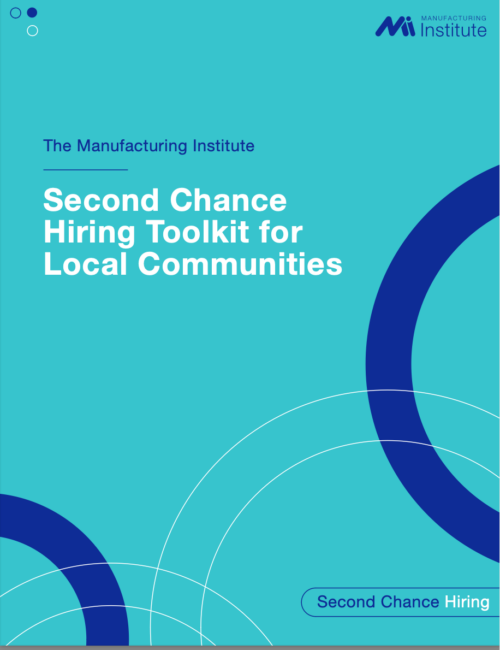
The Manufacturing Institute, the Washington, D.C.-headquartered nonprofit associated with the National Association of Manufacturers, has created the Second Chance Hiring Toolkit for Local Communities. This is the organization’s latest effort to encourage second chance hiring and ultimately help manufacturing companies of all types attract and keep the talent they need to succeed.
And there’s a desperate need. According to Pooja Tripathi, the Manufacturing Institute’s director, workforce initiatives, who moderated a recent MI webinar:
- Manufacturers will need to fill 4 million jobs by 2030.
- 2.1 million of these jobs could go unfilled.
- 1 in 4 Americans possesses a criminal record.
This problem could prove challenging for manufacturers, but the MI is working hard to help them solve it. Over the past two years the nonprofit has created a variety of initiatives – including pilot programs, webinars, research, case studies and what it calls Office Hours, a quarterly group forum in which employers who are considering a second chance hiring program can get their questions answered.
Its newest venture, the Second Chance Hiring Toolkit for Local Communities, guides organizations and coalitions – including individual manufacturers, state and local manufacturing associations, chambers of commerce and other organizations – through the process of becoming a hub organization and establishing a place-based second chance employment hiring program. An initiative like the one proposed in the toolkit involves multiple employers and is similar to those that the MI has helped organize as pilot projects in Texas and Georgia.
The MI encourages the hub organization to begin by soliciting a group of four to eight employers interested in using second chance hiring to augment their workforce. The group will also ultimately include one or more reentry organizations that deal with job seekers who have previous justice involvement and a consulting firm like Envoy to provide technical and programming guidance.
Five steps toward second chance hiring
The toolkit outlines five major steps that leaders of hub organizations and companies must take to create a second chance initiative – and how to accomplish them.
These are:
Plan – First of all, it’s important to set goals, outlining what you want the initiative to achieve, who might be best to choose as strategic partners – other companies and community organizations – and how you will determine success. Another part of the plan is to thoroughly understand your local market, including laws related to second chance employment and the regulatory environment of the industries of prospective cohort members, as well as your area’s major industries and the employment challenges they face.
Partner – The first partners to seek out are other employers. You may prefer a sector partnership model, choosing a group of companies in the same industry as yours or a diverse group in the same geographical region. The next partner you need to engage is one or more community organizations that have established effective workforce development programs for second chance job seekers. The MI has developed a Community Partnership Scorecard to help you do this. The third partner should be a content expert (consulting firm) that can give support in the technical, training and communications areas.
Equip – Employers need to be equipped with knowledge. They should thoroughly understand the value of second chance hiring to be able to convince the key leaders in their company of its business and community benefits. They need to learn HR best practices related to hiring those with a history of justice involvement, including practices related to job postings, interviewing and background checks. And, in addition, they must be aware of how to deliver the necessary information. The MI recommends considering participating in existing programs – the Society for Human Resources Management (SHRM)’s Getting Talent Back to Work certificate program, for example – to do this.
Implement – In this step, the hub organization(s) will work with the content expert to support cohort-member companies as they begin to recruit second chance candidates, taking what they learned and putting it into practice. The hub will make sure that everything is working smoothly and that employers develop good relationships with their community partners and arrange site visits so those partners understand the company and the types of positions better.
The toolkit also highlights four organizations and companies and what they have done to institute – or contribute to – second chance hiring. In addition there is a list of resources to gain knowledge from.
Continue to learn and publicize success
Once the program is established, employers should publicize their success by offering to be part of case studies and gaining attention in the media. They should also continue to learn from experts and may want to bring in new companies on a regular basis. By doing so, the practice of second chance hiring will continue to grow and prosper
In closing, it’s important to mention that the above outline and the related process in the MI tool kit is quite thorough and complete and may feel intimidating or overwhelming for some people. So, take from it the pieces that will work for you and don’t be distracted by what you may feel is excessive or not within your budget for what you are trying to bring to life. The most important takeaway is to get started and do something to begin offering second chance hiring.

